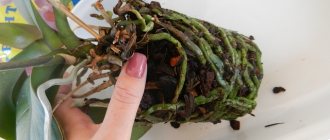When do daffodils need replanting?
Narcissus is a perennial bulbous plant. During the season, it forms several new bulbs (babies). Every year there are more of them. The average value of the reproduction coefficient of narcissus bulbs is 1:4. There comes a time when they feel cramped in the curtain. Gardeners will know about the need for replanting by external signs:
- the size of flowers and the height of the bush decreases;
- the buds dry out without blooming;
- leaves begin to turn yellow and dry out early;
- flowering is scanty.
The forced need for a transplant occurs after 3-4 years.
How to store daffodil bulbs at home
Many are also interested in how to store daffodil primrose bulbs. Daffodil tubers are laid out in the open air for several hours, but not in the sun; hot rays can cause burns. After the soil from the roots has begun to crumble, they can be moved to a well-ventilated barn, the temperature in which does not exceed 20°C. In such a place you can perfectly preserve planting material. Gardeners also use other storage methods:
- in the basements in spacious boxes. You can lay them in layers, but you need to separate them with sheets of newspaper;
- you can hang the bulbs in a canvas (tulle or nylon) bag;
- if there are few daffodils, then they can be planted in the ground using flower pots. Then you need to tediously put the flowers in the basement for the winter, and in the spring just transfer them into the prepared holes;
- owners of summer cottages are trying to store seed on the balcony. This method is not suitable for winter storage;
- storing in the refrigerator is not recommended for several reasons: the bulbs do not tolerate moisture, and if you put them in a tightly closed bag, they will suffocate, since the specific gas emitted by the tubers will accumulate.
It is impossible to store daffodils for more than 3-4 months, so in the fall, before the onset of frost, you need to have time to plant the bulbs in open ground.
Storage methods until autumn
The maximum shelf life of bulbs until spring is 1-2 months. Leaving them indoors for a longer period will negatively affect the quality of flowering next year. For storage, choose a dry room where there is no bright sunny color. It must provide natural or artificial ventilation.
To preserve daffodil bulbs you can use:
- cellar or basement;
- loggia or balcony;
- barn;
- veranda.
The temperature should vary throughout the storage period. In the first month, daffodils are stored at +17-18 °C, then 2-3 weeks before planting it is reduced to +9-10 °C. Temperature changes are determined by the characteristics of the culture. If the temperature rises above +18 °C, the bulbs may germinate ahead of time at home.
Cardboard or wooden shallow boxes are used as storage containers. They must have good ventilation. The bulbs are placed in one layer. Every week, planting material is inspected and diseased or rotten specimens are removed.
Purposes of transplantation
Transplantation is carried out not only for the purpose of rejuvenating the bush. Narcissus bulbs are dug up for subsequent forcing. For this purpose, certain large-flowered varieties with tall peduncles are grown.
To obtain material for forcing, the bulbs are dug up annually.
An extraordinary transplant is carried out if the plant does not bloom. Flower buds are not formed when planted in the wrong place, due to freezing or disease. Replanting helps eliminate these problems and stimulate flowering.
What to do if daffodils have sprouted
Situations when daffodils manage to germinate in the autumn are not uncommon; this usually happens for the following reasons:
- The region in which the planting took place is characterized by too mild climatic conditions, or in a particular year the autumn simply turned out to be quite warm.
- A violation of the planting deadlines was recorded, and it was carried out before the beginning or mid-August.
- The onset of a long and strong thaw in the middle or end of autumn.
Today, weather anomalies are observed very often, so the gardener must know how to react to the autumn germination of daffodils, because this requires him to take additional actions:
- Initially, additional mulching of the soil is required; for this you can use peat, sawdust and dry fallen leaves. It is allowed to mix the above components in equal proportions. The thickness of the layer can be from 2 to 5 cm depending on the height of the sprout.
- It may be necessary to create additional insulating shelter. These measures, as well as mulching, should be carried out after a stable cold snap, when thaws are no longer expected. In this case, you need to have time to meet the deadline before the temperature drops to -5°C or lower, as this can lead to the daffodils freezing.
- Sprouted tubers should not be used for forcing. The presence of sprouts indicates their rooting, so during digging there is a risk of damage to the root shoots, in addition, the procedure for undergoing the necessary cooling will be considered incomplete.
Why in autumn and not in spring?
Daffodils belong to the group of ephemeroids - perennials with a short dormant period. It begins immediately after flowering, when the leaves die. Lasts no more than 4 weeks. In most regions, the end of the dormant period occurs at the end of August.
After 3-4 weeks, the plant begins a new period of activity, during which it grows new roots. Therefore, an autumn transplant is necessary. You can’t delay with her. The second ten days of September is the deadline for the middle zone. If planted later, the bulbs will not have time to take root.
It takes 4 weeks for the bulb to root . Spring planting gives poor results. It should be carried out when the soil warms up to 10 °C. Before the heat, the roots do not have time to form. Therefore, flowering does not occur.
Is it possible to plant daffodils in spring?
Many people believe that it is impossible to plant daffodil bulbs in the spring. In fact, this is not so: you can place planting material in the ground with the arrival of spring warmth, but in this case you should not expect a quick start to flowering.
It often happens that high-quality planting material appears in late autumn or even winter, when planting in the garden is impossible. In this case, it is worth putting the bulbs aside until spring and only after the soil has completely thawed, transplant them into a flower bed (Figure 4).
It is extremely important to treat the planting material with cold, keeping it for 2-3 months at a temperature of +1+3 degrees. This is directly related to the biological characteristics of the flower
Without exposure to cold, the bulbs simply will not be able to take root in the soil and bloom in time.
Figure 4. For spring planting, it is better to use already grown seedlings
Apart from cold treatment, there are no special differences between spring and autumn planting. In the southern regions, the procedure can be carried out as early as March, but in temperate climates and the middle zone, it is better to postpone transplanting bulbs to a flowerbed until mid- or late April. In general, it is necessary to monitor the condition of the soil: when it has completely thawed, you can begin to form a flower bed with daffodils
In addition, experienced gardeners recommend paying attention to the air temperature: plants take root best at +5+7 degrees Celsius
Nuances of the procedure
Caring for daffodils takes little time, which is why gardeners love this plant so much. Transplantation is the most labor-intensive process. It's not difficult to master.
See also
Description and characteristics of Tahiti variety narcissus, care and useRead
Transplanting blooming daffodils
If the bush blooms profusely and does not get sick, then it is transplanted to another place every 4 years. Sometimes a variety needs to be changed more frequently due to varietal characteristics. This is reported when purchasing a specific type. Large bulbs are planted in increments of 15 cm, medium ones - 10 cm, small ones (babies) - 7 cm.
Dates for planting daffodils in the fall
Planting daffodils in the fall should begin when the soil temperature has dropped to 9 °C and remain there for 7–10 days. If the temperature drops below, then the bulb will not have time to take root, which will lead to its death.
Experts recommend replanting the daffodil before the third ten days of September.
When determining the timing, it is important to take into account the specific weather forecast and the region where the transplant takes place. In warm regions, daffodils can be planted in the fall at a later date.
When to plant daffodils in the fall in the Moscow region
Planting daffodils in the fall in the Moscow region should be done in the first half of September. You need to focus on the soil temperature, which should last for two weeks around 10 °C. If you plant the bulbs later, the plant will not have time to prepare for winter. At best, a plant planted late in the spring will not produce flowers; at worst, it will not survive the winter.
When to plant daffodils in autumn in Siberia
The Siberian region has a harsh climate and short summers. Therefore, as soon as the required soil temperature is established, it is necessary to begin replanting. Usually this is the first two weeks of September
It is very important to focus on the weather forecast. So that frost does not occur and does not deprive the flower of the opportunity to prepare for winter
Caring for daffodils after transplantation
In autumn, the ridge is covered with a layer of mulch. Peat, humus, and crushed bark are used for this purpose. If there is little snowfall in winter, the ridge is covered with lutrasil. In spring, the shelter is removed. Urea granules are scattered over the surface of the earth.
From early spring until July, daffodils are watered regularly. Recommended water consumption is 3-4 buckets per 1 m². During the summer, at least 2 fertilizings are carried out with potassium-phosphorus fertilizers, before and after flowering.
After watering, the soil is loosened shallowly and sprinkled with ash. It protects flowers from pests and serves as fertilizer. It contains potassium and other useful microelements. Weeds are regularly removed from the flowerbed.
Further care
After planting, daffodils require some care. It consists of the following:
- Fertilizer. Complex mineral fertilizers are good during the budding period. They can be purchased at a specialized store as a ready-made product, or you can make them yourself. Potassium sulfate, superphosphate and urea (1 teaspoon each) are dissolved in 10 liters of water. The solution is distributed over the soil at the rate of 5 liters per 1 square meter. During the period of active flowering, it is better to provide fertilizing containing nitrogen, phosphorus and potassium. To prepare the mixture, you can add 2 teaspoons of Agricol and 1 teaspoon of nitroammophoska to a bucket of water.
- Moderate watering. Here you should take into account the region - in the south there may be no rain for a long time, and therefore it is important to water the daffodils, preventing them from drying out. It is equally important to prevent the bulbs from becoming waterlogged - this can cause them to rot. In the central and northern regions of the country, natural moisture is usually sufficient for daffodils. They are watered only when there is no rain for a long time.
- Weeding. Daffodils need protection from weeds. The latter steal nutrients from the soil and can cause various plant diseases. Weeds must be removed from the flowerbed. You should also additionally loosen the soil after each watering. Thanks to this procedure, nutrients will be better absorbed by the plant, and the roots will have access to air.
- Prevention of diseases. The most dangerous enemies of daffodils are considered to be soil bacteria and fungi (for example, gray rot, fusarium, bacterial scab). Diseases are best treated in the initial stages. So, with fusarium, the roots of the plant become covered with brown spots. The bulbs need to be immersed for 6 hours in a 1% formaldehyde solution, and then sprinkled with Fundazol. Gray rot leaves spots on stems and leaves and causes buds to wither. Eliminated by spraying the plant with 1% Bordeaux mixture. To combat bacterial scab (which leaves reddish glossy spots on the bulb), you need to remove all spots and sprinkle the sections with crushed coal.
When should you not replant daffodils?
You can destroy the bulbs if you replant them during flowering. All bulbous plants that bloom in early spring are replanted in the fall. Narcissists are no exception. A bulb transplanted in summer or late spring will simply sit in the ground without forming roots. At this time, it may be attacked by pests or a fungal infection.
You cannot dig a nest while the narcissus leaves are green and elastic. At least 6 weeks must pass from flowering. During this time, the bulbs accumulate nutrients and flower buds form.
But even fully matured specimens cannot be replanted in late autumn. They won't have time to take root. In the southern regions the deadline is the end of September. In the regions of the middle zone, all work with daffodils must be completed before September 10-15. They are also not replanted in winter.
Planting daffodils in open ground
We recommend reading our other articles
- Growing green onions
- How many days does a duck sit on eggs?
- Pear variety Skorospelka from Michurinsk
- Raspberry variety "Reward"
Daffodils are easy-to-care flowers that even a young amateur gardener can grow. In any case, this applies to ordinary, widely available varieties and hybrids. But even with them you need to be able to handle in order to achieve lush flowering.
These flowers are usually planted from the last days of August to mid-September - that is, in the fall. The planting site should be sunny, with only slight shade possible, with natural protection from blowing. You can plant these flowers in any way you like - in rows, bushes according to a certain pattern, or any other method.
Interesting! The tacet species, like most other species, are planted only in the open air, otherwise they will only produce scanty flowering. But hybrid species with rich colors (pink, scarlet, deep orange) should be planted in partial shade, otherwise the color of the petals may fade.
The soil should be fairly light and fertilized. Sand is always added to clayey soil. Before planting, the area is dug up and minerals (superphosphate and potassium salt) are added. Depending on the type of soil, the bulbs are buried in different ways. So, in clay soil, the bulbs are placed at a depth of 5-7 cm, and in light soil - up to 15 cm. The rows are made at a distance of 30 cm from each other, 15-25 cm are left between the bulbs. After planting, the soil is compacted a little and left for 2 weeks, so that the bulbs take root.
Step-by-step transplant instructions
Transplantation begins when the average daily temperature does not exceed 10 °C. In bulbous plants, active root formation begins at a soil temperature of 9 °C. The main conditions for successful autumn planting of daffodils:
- roots have formed;
- the bulb did not begin to grow.
The flowering time and the rate of formation of children depend on the planting depth. It is optimal to deepen the bulb to 3 times its height. When they want to achieve early flowering and a large number of children, the bulb is planted smaller.
Choosing a transfer site
In the garden, salvia, tagetis, phlox, and delphinium will be good predecessors for narcissus. The perennial bulbous plant grows well in sun and partial shade. There are some varieties that need a lot of sunlight.
Most varieties need 3-4 hours of bright light. But in sunny areas, daffodils bloom more abundantly and last longer.
Soil preparation
For optimal growth and development, daffodils need well-aerated soils with a pH level of 6-7. They are very sensitive to a lack of potassium and phosphorus in the soil. When preparing the soil, you cannot add fresh organic matter and fertilizers containing chlorine (potassium chloride).
See also
Description and characteristics of the Walz variety narcissus, planting and careRead
The soil in the flowerbed is dug up. Humus and mineral fertilizers are added. Planting bulbs is carried out according to a simple scheme. First, they dig a trench (hole) 20-25 cm deep. River sand and ash 5-7 cm thick are poured onto the bottom. The bulbs are laid out, covered with fertile soil and watered.
How to prepare plants for transplanting?
You cannot delay the transfer. The leaves will wither, the bush may simply not be found. You need to dig the nest carefully. The blade of the shovel should be inserted slightly away from the edge of the curtain, so as not to inadvertently touch the bulbs.
They sit at a depth of 25-30 cm. The nest is removed along with a lump of earth. They take it apart into bulbs. Try not to damage the roots. They are separated by hand and garden tools are used to remove remaining leaves. Soft, rotten and mechanically damaged specimens must be disposed of.
You can store children and large bulbs without soil for several weeks. They are disinfected in a manganese solution, dried, placed in paper bags and taken to a cool, dry room. Recommended storage temperature is 13 °C. Part of the nest can be left. After separating the required number of children and bulbs, it can be returned to its original place. To restore fertility, mineral fertilizers are added to the soil.
Selecting a location for transplantation and preparing the soil
Before moving daffodils to a new location, it will need to be assessed against a number of criteria, since it must meet the following requirements:
- Daffodils are very demanding of lighting, so it is necessary to choose open places , near which there are no large structures, buildings, trees, tall bushes and other objects that can limit the access of sunlight. If it is not possible to provide such conditions, you can transplant into partial shade; some varieties respond favorably to such places, and they notice an increase in the brightness of the inflorescences and an extension of the flowering period.
- The landing site must be drained and pre-leveled.
- Daffodils prefer to grow in places with moist soil and like frequent watering, but care must be taken when planting them in soil with a clay structure, as this can lead to the accumulation of excess moisture and rotting of the root system. It is also not recommended to choose places with shallow groundwater.
- These plants are undemanding in terms of chemical composition, acidity level and soil type. However, they grow slightly less well if the chosen location is dominated by light soil with a sandy texture, since it does not actually retain heat in winter.
- When planting in places with a predominance of heavy clay soil, it is recommended to improve its composition and structure by adding humus of plant origin, peat or coarse sand.
- Growing in peat soil can only be successful if the acidity is neutral; if the pH is 6 or below this, then preliminary liming is required. For these purposes, lime carbonate is used, adding 350-400 grams to the ground. can change the indicator by one per square meter.
- Before planting, the selected area must be loosened and dug to a depth of about 35-40 cm , and up to 15-20 kg of plant humus per square meter can be added to the soil.
- 2-2.5 weeks before planting in a new place, you can add superphosphate or potassium salt to the soil ; the recommended volume is 50 grams. and 30 gr. for each square meter, respectively.
The main mistakes of novice gardeners
Delay in spring watering is the biggest mistake. Daffodils need a lot of moisture at the very beginning of the growing season. Water abundantly at the very beginning of spring. Before this, urea or carbamide is scattered over the soil surface.
For many beginning gardeners, daffodils do not bloom. Reasons for this:
- the bush has not been replanted for a long time;
- The plant is affected by the narcissus fly.
To prevent daffodil flies, the bulbs are treated with Karbofos solution before planting. A delay in flowering and a small number of flower stalks occurs due to a lack of potassium and phosphorus in the soil. Flower growers forget to water the daffodils with a liquid solution of superphosphate and potassium sulfate in August.
In the garden, daffodils coexist well with tall flowering perennials and ornamental shrubs. It is worth planting several different varieties of bulbous perennials in flower beds. They will bloom at different times. The following varieties are popular among florists: tacet, cyclamen, and terry.
Diseases and pests of daffodils
Bacterial rot and viral infections can become a problem.
The first appear due to waterlogging, application of fresh manure or excess nitrogen-containing fertilizers. The rot is clearly visible when dug up; they are cut out and the cut site is treated.
The latter are carried by leaf-eating insects or tools when cutting flowers. A diseased plant is distinguished by multi-colored strokes on the petals and leaves. The specimen is immediately dug up along with the bulb, trying not to touch other plants, and destroyed, because There is no effective treatment.
Parasites for daffodils are nematodes (root and foliar), as well as mole crickets, slugs and daffodil flies. In open ground, insecticides are ineffective, but healthy and well-developed plants cope with insect attacks.
As you can see, there are no particular difficulties with planting daffodils. Even an inexperienced beginner can perform all the steps. But in the spring, when the flower beds are full of yellow, orange or white flowers with pink centers, you will experience true aesthetic pleasure looking at such divine beauty.
Digging
It is worth noting that daffodils, unlike tulips, do not rest, so you should not dig them up and store them. The shelf life of the bulbs is short, otherwise the roots may dry out, as well as the bulbs themselves.
When can you replant daffodils and dig up the bulbs? This can be understood by the external signs of the plant, which include:
- Condition of the bush. If yellow stems appear on the plant and they are already beginning to bend, then this indicates that you need to start replanting the daffodils. But you should not cut off the yellow stems, because the bulbs feed on them. The timing of transplantation depends on the type of flower, but it is usually done at the end of June or beginning of July. There is no need to delay replanting, because after flowering the leaves quickly begin to dry and you can lose the place where the bulb was planted.
- Age. If the age of the plant is known, then you can easily understand when it should be replanted. For a bush to be beautiful, you should not disturb it for three years. After this time, even by appearance it will be possible to understand that the daffodils need a transplant. The bush will be thickened, and the bulbs will become crowded, and they will begin to protrude from the ground. Under normal conditions, a bush can live for about 5 years in one place and only then can you start replanting the daffodils.
- Transplantation can be done immediately after flowering, but it may happen that they die. If you want to transplant after flowering, it is best to choose August for this.
After digging the bulbs, you need to immediately remove the foliage, then put them in a dark but dry place at a temperature of 17 degrees. When the scales begin to dry out, they can be removed and the planting material can be cleared from the soil. After this, they should be thoroughly examined, sorted by size and the diseased ones removed. Before planting, be sure to keep the bulbs in a solution of potassium permanganate.
Excellent times are spring and autumn. Transplanting work in spring is slightly different from autumn in that it will be difficult to dig the bulbs out of the frozen ground. If at this time the plant has already woken up and begun to grow, then replanting can delay flowering, or the flower may not bloom at all this year. Therefore, replanting is best done in the fall.
What to do after flowering?
The daffodils have faded, and the question of when to remove them is acute. Beginners may not know that the foliage of faded daffodils is not cut off for about 2 months. It is through the leaves that ultraviolet light reaches the bulbs. And only after 2 (or even 3 months), when the foliage has completely dried out, can it be carefully trimmed without haste.
In autumn, flowers can be fed with water-soluble fertilizers; this treatment is necessary if the flowering season was problematic and not only for this reason. Young plants can be covered with a layer of humus or leaf turf on top. And they will lie in such a “fur coat” all winter.
Do not dig up young bulbs with stems after the growing season. Digging up daffodils occurs on average once every 2 years, and this is done so that the mother bush is “shared” by the young children. If the bulb is mature, three years old, it is dug up after the growing season at the end of the second summer month or at the very beginning of August.
You need to understand that when the foliage of a daffodil has dried up, this does not mean the onset of a dormant period. Flowers still breathe, grow, and receive nutrients from the soil. But the material dug up for transplantation also breathes, so you should not delay replanting for more than 2 months.
How to plant daffodils in open ground
The technology that needs to be followed when planting daffodils in open ground is quite simple and usually does not cause any difficulties even for beginners in this matter.
A detailed description of this process is given below:
Initially, the soil at the site of the future flower bed is carefully dug up and loosened; if necessary, a small amount of coarse sand or suitable fertilizer mixtures can be added to it.
Then the planting holes for the bulbs are prepared. Their depth is determined individually in each specific case; usually it is equal to triple the size of the tuber itself. In most cases, the figure is 10-13 cm for adult bulbs and 8-10 cm for children, but the quality of the soil is also of a certain importance: if planting is done in fairly light soil, the depth can be further increased by another 5 cm.
A distance of about 15-20 cm should always be maintained between adjacent holes, but when growing miniature varieties it can be reduced to 10 cm
If planting is carried out with the aim of quickly producing children, then the distance increases to 25-30 cm, which will allow the tubers to develop and grow faster.
A small amount of sand is poured onto the bottom of the hole to form a thin layer that will act as drainage and also prevent direct contact of the planting material with the applied fertilizers.
Then the bulb itself is carefully placed inside: it must be positioned correctly so that the root shoots are directed downward.
The planting site is slightly moistened if there has been no precipitation for a long time, and then covered with a mixture of sand and garden soil. At this point, the planting procedure can be considered complete; in the future, you only need to care for the daffodils.
Timing for digging bulbs
At one time, I studied a bunch of magazines (there was no Internet yet) and collected knowledge bit by bit. I learned a few rules for myself:
- It is imperative to dig up heat-loving bulbous plants (gladiolus, begonia), they need to rest at a constant temperature (+10...+14 °C) and humidity (50-60%);
- bulb roots can be dug up immediately after the foliage withers:
- Children from single plants (tulips, lilies) should be separated more often; bush crops (daffodils, crocuses) should not be disturbed often.
Today I will talk about bulbous flowers that are not afraid of frost, which need to be dug up in the summer and planted in the fall.
Tulips
Every year I dig up only large, varietal flowers. Others sit in the ground until the buds are crushed. During the rainy season, I cover the plantings with cut-off plastic bottles and make umbrellas for the flowers.
I take out the varietal bulbs from the ground when the honeysuckle ripens. This is a great guide. I rarely look at the lunar calendar. Later, in mid-July, it is better not to touch the flowers; they tolerate our climate well.
Daffodils
Daffodil false bulbs are often not disturbed. These flowers like to grow in dense groups. I replant them when the strawberries are ripening.
In a container with water, false bulbs will remain fresh for up to a month; the main thing is to avoid stagnation of water and change it more often.
Hyacinths
These flowers love loose soil; the bulb can be removed from it by hand, picking it up from below with three fingers. I clean the planting material after drying for two days on the veranda, scattering what I dug up on old newspapers. I immediately separate the babies, plant them in pots, and take them home for the winter.
Then I remove the leaves and roots with a knife (I pre-treat the blade with peroxide) and exfoliate the keratinized scales. I store the prepared planting material until autumn in the garden house - I put it in a container with sand and periodically moisten it.
Lilies
The bulbs of these delicate plants dry out quickly. I store them outdoors for no more than 3-4 days. If there is time, I replant immediately, after removing the subbulbs - small young cones.
Asian hybrids and LAs multiply too much, I dig them up every year and remove all the bulbs. Oriental, tubular, OT hybrids, Martagon can sit in one place for up to seven years. Young shoots do not interfere with the mother's bulbs. Recommended transplant dates: mid-August – first half of September.
I do not recommend replanting all the lilies at once, as there will be confusion with the children. In the literature, the timing of digging up hybrids is divided, I think, precisely for this purpose.
Crocuses
I don’t touch the corms until the planting thickens or someone asks me to dig up a few plants. I have several varieties, all behave approximately the same. I divide late varieties only in spring, the rest in mid-summer.
When you want to get large buds, the bulbs can be kept in damp peat in the cellar or vegetable compartment of the refrigerator for up to two months. In this case, the plant is dug up immediately after flowering and moved to a new location at the end of autumn.
Imperial hazel grouse
This is a tropical crop. To lay a bud, the bulb needs to warm up well. To make the flower happy every year, it is dug up after the petals fall. Recommended temperature – +30 °C. I take the bulbs home, place them in a container with damp peat, place it on the windowsill of a window facing east, and cover the top with 4 layers of light cloth or gauze. A couple of times a week I wet the fabric with a spray bottle.
One year I didn’t dig up the row on time and waited until the strawberries ripened. As a result, many of the bulbs had to be thrown away; they rotted. Towards the end of storage, thin young roots appear on the bulbs. This is the signal to land. I must first spill the soil with a warm solution of manganese to repel insects and kill fungal spores.
Small-bulbous
Kandyk, scylla, and other small-bulbed flowers grow in one place for up to five years. Then it is advisable to divide them so that they do not interfere with each other. Muscari, white flowers, snowdrops become larger after transplantation. I dig up small bulbous plants when their leaves begin to dry out.
In hot summers this happens in August. When it rains frequently, the leaves remain fresh until September. After drying in the shade for 3-4 days, I place the bulbs in a new place. If I don’t have time to replant flowers, I put them in a shoebox and cover them with slightly damp peat or sand - whatever I have on hand. I don’t touch young plantings until they’re seven years old; if you trim the leaves every year, new shoots don’t develop and large buds are formed for next spring.











